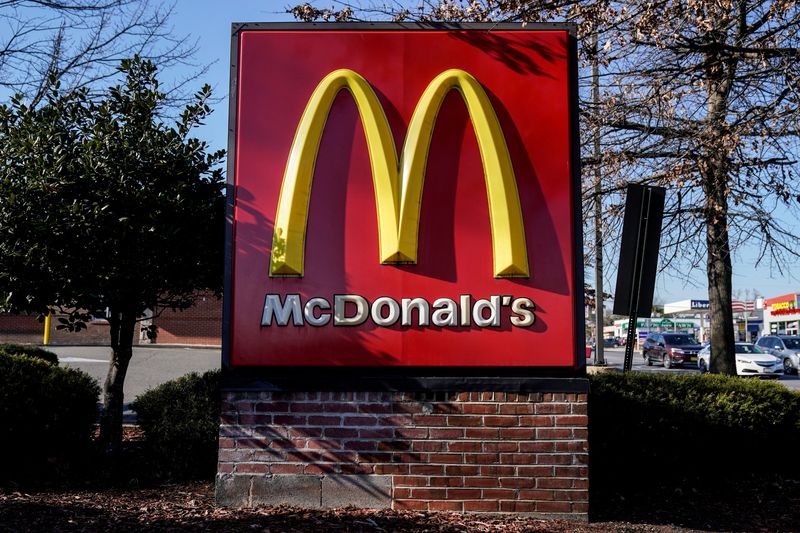By Waylon Cunningham
SAN ANTONIO, Texas (Reuters) - Runaway prices at U.S. fast-food joints and restaurants have made people skittish down the income ladder and executives at chains including McDonald's and Wendy’s recently said they worry about losing business from those on the tightest budgets.
Roughly a quarter of low-income consumers, defined as those making less than $50,000 a year, said they were eating less fast food and about half said they were making fewer trips to fast-casual and full-service dining establishments, according to polling in February by Revenue Management Solutions, a consulting firm.
The rising price of food is contributing to budget-conscious diners cutting back.
Whether consumed at home or in a restaurant, food prices rose 20% from Jan. 2021 to Jan. 2024, the fastest jump on record. A recent census Household Pulse Survey showed half of people earning less than $35,000 a year had difficulty paying everyday expenses, and nearly 80% were moderately or “very” stressed by recent price increases.
Lauren Oxford, a musician who works part time at a bed-and-breakfast in Tennessee, said she used to stop by McDonald's after running errands, treating herself to two double hamburgers, fries and a drink, for less than $5. As prices rose, she switched to smaller hamburgers and stopped getting the drink.
But after a year in which McDonald's franchisees drove prices up about 10% according to the company's executives, she’s going to McDonald's less in general. “Now I don’t know if I can justify that.”
In the Fed’s most recent Beige Book compendium of anecdotal reports gathered from business and community contacts around the country, 7 of 12 regional Fed districts reported low-income consumers were changing spending habits in search of bargains, seeking more help from community groups, or struggling to access credit.
About one-third of Black American households, and 21% of white American households, earned less than $35,000 in 2022, according to the latest available U.S. census data.
For fast-food companies that often promote an image of affordability, low-income consumers are a significant portion of the customer base and a bellwether for longer-term trends. But they are typically the first to cut back spending and the last to come back.
But now, chains may be less likely to chase customers as hard as they have in the past because even with a drop in traffic, sales have remained consistent supported by increased prices.
Fast food companies aren't "in a hurry to take traffic over profit the way they were a decade ago,” said Mike Lukianoff, CEO of SignalFlare.ai and a veteran consultant in the fast food industry.
For example back in 2008, Subway introduced its nationwide $5 footlong, which became the poster sandwich for the Great Recession. That spurred rivals to introduce extreme value deals for budget-conscious customers, such as “$5 Fill-Up Boxes" at Yum! Brands (NYSE:YUM) KFC.
In 2016, McDonald’s (NYSE:MCD), after a prolonged slump in sales, introduced a bundle deal it called “McPick 2”, allowing customers to choose 2 items, like a McDouble, for $2. Within months, Wendy’s offered a four for $4 deal. Burger King offered five for $4. Pizza Hut had a $5 “flavor menu.”
APP-DRIVEN DISCOUNTS
Now, instead of across-the-board menu slashes and broad discounts, industry analysts say chains are being more selective, aiming them at specific demographics or limiting them to specific meal times or channels, such as its app or only through delivery.
McDonald's executives told investors in February that it would rely on its existing "value menu" to appeal to low-income consumers who might be tempted to eat packaged food at home instead. CFO Ian Borden said affordability is core to the brand, and the company would continue "evolving" its value offerings.
“The battleground is certainly with that low-income consumer,” McDonald’s CEO Chris Kempczinski told investors, referring to people making less than $45,000.
Wendy’s recently introduced a limited-time $1 burger — available only through its app. Its CFO Gunther Plosch told investors in February that among lower-income customers, their traffic is down but their share with the general market is unchanged.
For major fast-food companies, loyalty apps are the go-to strategy among major brands to increase retention and the average amount of money spent. The upside for chains, David Henkes, senior principal with Technomic said, is that they capture more transaction data and demographic data for the consumer, “which is a trade-off many are happy to do.”
For example, McDonald's frequently offers in-app discounts, such as 20% off an order or free delivery with a large enough order.
Domino’s halved the minimum purchase price to get points in its loyalty program, to $5 from $10, its CEO told investors at a conference in January. It also reduced the number of purchases needed to get a free pizza to as few as two from six. “And so essentially, for this lower-income consumer, we’ve made the brand more accessible,” CEO Russell Weiner said.

To be sure, not every chain is seeing weakness among low-income customers. At Taco Bell, which sells a single taco for $1.40 at many of its stores in San Antonio, locations in low-income markets did better than other locations, Yum! CEO David Gibbs told investors in February.
McDonald's still holds its appeal for Andreas Garay, a retail worker eating at a McDonald's in westside San Antonio. He said he plans to keep his coffee-and-Big-Mac habit-- even if prices continue going up.
